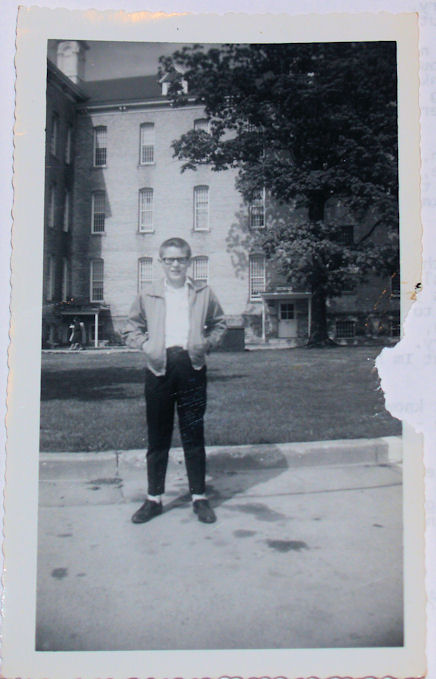
Ronny Larson was a patient at Traverse City State Hospital. (1965-1971)
He was 12 when his parents committed him to the institution.
Photo Courtesy of Ronny Larson
“It was a cold snowy day in mid January 1965. We started out just before daylight. The ride was very quiet and long. At times we were in a complete whiteout due to a strong lake effect storm pounding the west coast of Michigan. The heater was on high but I was still cold in the back seat. As I was gazing out the window, looking to the left, I saw a buffalo. I knew that I was not going to be returning home anytime soon. This is the first day of my distorted memory.” This was an excerpt from Ronny’s draft for his book “Where the Buffalos Roam.”
Ronny had started to write a book about his life at the Traverse City State Hospital. He was institutionalized at twelve years old until he turned eighteen. (1965-1971)
I found this thread of posts by prior patients and staff at www.kirkbridebuildings.com The Traverse City page was filled with posts from Ronny Larson. He and a few others opened up about their experiences in Hall 18.
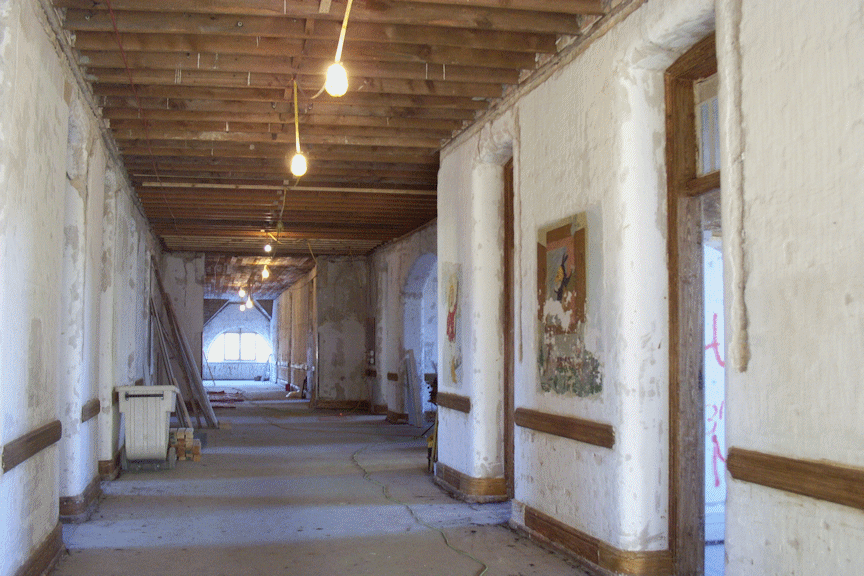
Courtesy of Ronny Larson
“Receiving” was the first stop anyone made when being brought to the asylum. “I remember being stripped of all my clothes and the looking and the prodding of my body. I felt very small. All my meager possessions were taken away. I was afraid and confused. There were questions, ink blots and more questions. I remember the enema being forced upon me.” He was held down by attendants and then sat on the toilet for 15 minutes while being observed. “I have never figured out why.”
“Young and old sat quietly in the dayroom . I was the only child there. I remember doing puzzles but never finishing them. Some of the pieces were missing.” (I sadly shake my head at the irony of this.)
Outside he would see children marching two by two. Ronny asked if he would get to join them. ‘We’ll see.’ was the answer.
Once a week Ronny would have therapy with Dr. Vasquez. There was a big mirror on one wall. One day he saw the lights were on inside an adjoining room revealing a movie camera. “I always knew I was being watched and filmed for what reason I do not know.”
Finally after thirty days, Mr. Curtice led Ronny through an underground tunnel and many cage like, locked doors to Hall 18. “The tunnel was always hot as it had the steam heated water pipes and electrical wires running through it. I enjoyed 1,000 plus trips through the tunnel.” Ronny recalled.

quicker and out of the public eye.
During the winter months one could walk through without needing a coat or boots.
A minimum stay for a person brought to the hospital was 30 days. Ronny was escorted to Hall 18 for an extended stay on the children’s ward.
Ronny explained, “The term dyslexia had not been defined in medical history. Although I was an average adolescent I was sent to a place where I could be “controlled.” “
Hall 18 – The Children’s Ward
“My cell was 8 X 8 feet across from the office. The walls were cold tile. The steel door had a small hatch left open. The keyed light switch was outside the room. Lights out at 10:00 pm.” Ronny shared that the kids had learned to turn the lights back on by reaching through the slot in the metal door and sliding their metal zipper pull through the switch pad.
There were 60 beds in 1968 Hall 18. Ronny shared that Hall 18 was filled to capacity, so they brought in more beds and put them wherever they would fit.
The drug room was to the right of the office. There were trays with holes to hold the paper cups. They had to open their mouth to show they had swallowed the pills. In 1967 liquid medication (Thorazine) was mixed in orange juice and dispensed to be sure each child received their dosage. “It tasted terrible!” Ronny reported.
Their strict schedule was adhered to by the staff.
7:00 am wake up and make beds – army style
7:30 am breakfast
8:00 am scrape tray – trays and silverware were counted
8:30 am line up for on campus school – two by two
4:00 pm return from school
5:00 pm dinner
(Ronny was yelled at for talking during dinner on his first day.)
5:30 – 7:30 pm medication and playing (outside good weather/ inside winter)
Wednesday nights were movie nights and Friday nights were dances.
7:30 pm line up for shower – stripped – four to a stall – a towel was around
the corner- brush teeth (once a day)
8:00 pm TV time – “Munsters” and “Adam’s Family”
10:00 pm Lights out – NO talking
(Ronny recalls hearing mouse traps going off and keeping him awake.)
Tuesdays and Friday the floor needed to be scrubbed, rinsed and waxed. It took two hours to apply the wax with socks on their feet then buffed with a Clark Buffer. “I still can’t stand the smell of paste wax.” Ronny noted.
On Saturdays Ronny had time to learn how to play the guitar. He was one of the few residents who was allowed to have a musical instrument. He also learned how to play pool.
On Sundays everyone was ‘forced’ to attend church. For the rest of the day they had to play quietly in their rooms because it was visiting day. Ronny didn’t have visitors.
There were three seclusion rooms next to the office. Each one was usually occupied. The punished child had a 7-14 day stay alone in the small cell. They were let out four times a day to use the bathroom. There was no furniture in these rooms. In two of the seclusion rooms one could stand on the door hinges and peer through the window at the top of the door to be able to view the TV. This first hand account of seclusion was revealed by Ronny.
Mr. Curtice would often take Ronny on walks around the campus so he could pick up paperwork. They often had to go through Hall 6 where ‘they kept the real crazy people.’ These patients would call out and claw at Ronny. Ronny remembers Mr. Curtice laughing. However, when Ronny was sick with a fever, Mr. Curtice was at his side as if Ronny was his own son, except for the policy of NO hugging the patients.
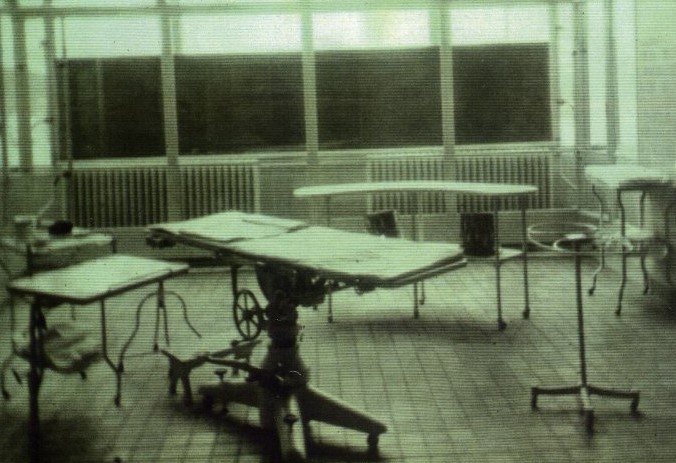
Photo Courtesy of Traverse City Historical Society
On their walks they went through C-2 and D-2 which were the medical wards. In those days there was a foot doctor and a surgical space. “This was the place where they had done lobotomies as well as shock treatments. The equipment was still there. I saw it. I did not know they couldn’t use it anymore. I thought I would be next!”
“In school Mr. Martin was kind, too.” Ronny recalled. “He treated everyone with respect. There were kids with Downs Syndrome, epileptics, eating disorders, severe depression and those who’d been abused. There were some with disorders that didn’t have names back then: Dyslexia, Attention Deficit Disorder and transgender. There was one boy who was convinced he was a girl and wanted everyone to call him Bev or Beverly. There was one who would change personality from one moment to the next. Two twelve year old giants who weighed 300 pounds each who just wanted to fit in. “
There were a few young patients, too. They were from five to nine years old. “I used to look after one of them, Little Davie. I would make his bed and dress him every morning. I made sure he was fed by getting his tray at every meal.” These kids had been homeless and never had visitors. “They would run around with towels as capes pretending they were super heroes. I found out that Davie is still institutionalized and still thinks he’s a super hero. I wonder if he would remember me, the one with the guitar.”
“I always kept an eye out for Davie, especially from the child predators. Us older kids knew who they were. Their arms were always lunging out for a quick feel. When I was twelve or so I smashed a few of them in the face for trying to touch me, the attendants would just laugh.”
“I always hated Dr. Thill. He never said much, but when he did talk, you were in big trouble. He always looked down when he walked and never smiled. Even when you were being nice to him he would bite like a bad dog. He is the only staff member I will never forgive.”
“I never felt cared for. It was like a prison for us and we felt like we did not belong there. I never wanted to go back. I always had nightmares of going back.”
One lady would take kids for occupational therapy to do what she’d call, ‘fun stuff.’ They would sew leather wallets and work on the Cherry Festival floats. They never saw the wallets again. They never attended any of the Cherry Festival parades.
After talking with a fellow resident Ronny recalled some good times. He remembered outings to the beach and the Sleeping Bear sand dunes. The group of youngsters were escorted around the Cherry Festival. He learned how to play pool. He remembered figuring out chords and strumming on the guitar. He made himself guitar picks from 78 shellac records. Monthly walks into town for Batman ice cream made him smile. Drying banana peels on the radiator so they could roll them up and smoke the banana ‘cigarette.’ There were trips through the tunnel to go to movie night and the monthly dances. In the winter the children often tobogganed on the hills by the farm area. He did break his ankle, but the sledding was fun.
When Ronny had broken his ankle only aspirin was dispensed to relive his pain. Aspirin was the only medication given for any type of discomfort. He had two surgeries on his testicles while he was a resident at Hall 18 and was only given aspirin. “I think any narcotics would have had side effects with the Thorazine. I am not sure on this but I do know first hand nothing stronger than aspirin was given for pain.”
The summer of Ronny’s two surgeries a female nurse “started her moves” on Ronny. “This will make you a man and you need to learn this.” The fat, ugly, hairy nurse told Ronny. This went on for several months behind closed doors.
Many patients had earned a ‘ground parole’ card where they could wander the paths and trails on campus for a designated time frame. One place Ronny like to go was the ‘Hippie Tree’ where he’d play his guitar. He has written several songs as part of healing from his time as a “Forgotten Child of Hall 18.”
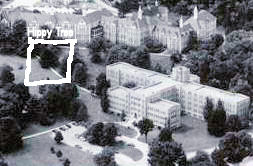
Ronny had a guitar (one of the only instruments on campus) and would play while sitting at the picnic table under the huge tree.
Locals and tourists have dubbed a different tree this same name. This ‘Hippie Tree’ located a quarter mile down a trail has it’s own urban legend as a portal to hell. It had been struck by lightning and the trunk was split into many pieces. If you walk around the perimeter of the painted tree it is said that you will open the portal and fall into hell.

behind the current Traverse Bay Public School Administration office.
When Ronny turned 18 in 1971 he was released from the hospital. He said someone told him he was “a snowball rolling downhill heading for hell.” In 1972 he joined the army and was stationed at Fort Clayton at the Panama Canal. Cocaine became his drug of choice. “It stopped the bad dreams of my life, if only for a while.” In 1980 he stopped using “hard drugs” and drinking although he smoked pot and found solace in Pink Floyd music. A psychiatrist prescribed Prozac. The dreams of having to go back to Traverse City State Hospital continued.
Ronny focused on his love of music and opened a guitar shop in North Carolina. He produced many songs where he played each instrument and layered the recordings.
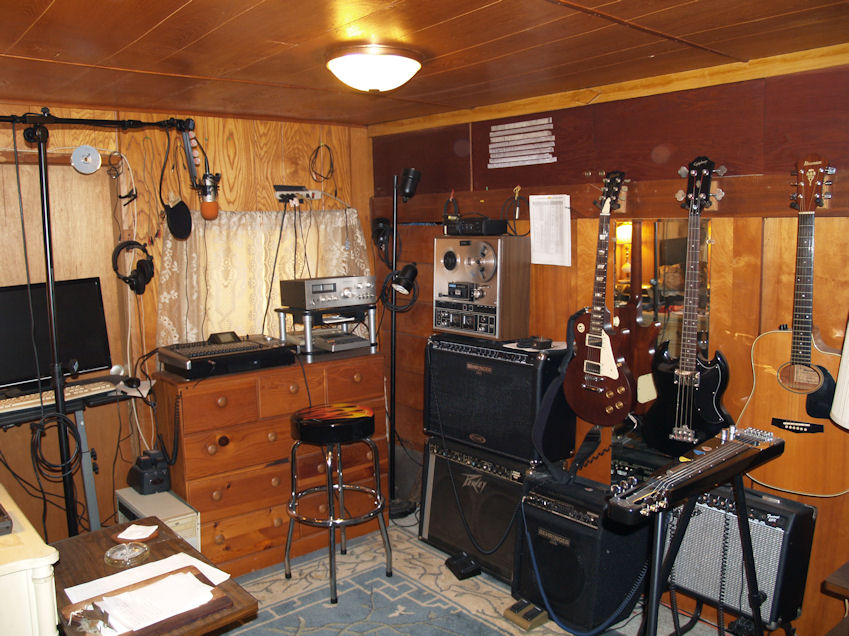
Ronny Larson’s recording studio
Photo Courtesy of Ronny Larson
Some of his song titles include: “Where the Buffalo Roam,” “Sudden Shock Dreams,” “HMH,” “Shame,” “Cat Nippin,” “Itchyme Swamp,” “Hot Sun,” “West Highway,” (The song of his life story.” “Heart Attack.” On his website he offered to give a walking lecture with his guitar on the grounds of the Traverse City State Hospital. To me this sounds like he has worked hard to make peace with his past.

Sadly, on Wednesday, August 5, 2009 Ronny posted that he hadn’t been around because he had a heart attack. He reported that he was tired. His number of entries slowed, but each new post focused on having the hope to have his book published. First Heidi was assisting him, followed by another woman and finally Greg.
Ronny posted, “I am at peace with myself and bear no hard feelings toward any of the staff. Heck, I’d like to hear from you, too.” He gave his email address.
After two years of posting memories on the Kirkbride site, Ronny made his last post on February 28, 2011. “Someone does not like my time line and is accusing me of lying to you all and stating I was never there. Think what you want . . . I will end my postings. You can thank MaxC. I am locking this thread from further posting.”
In November 2016 Ronny was diagnosed with stage four lung cancer. He turned over his website to www.simouthouse.com At the bottom of his webpage “My Story” he wrote, “See you in Heaven. -Ronny.”
Sadly, Ronny Larson passed away on December 23, 2016 which happened to be his birthday.
His website is still available to read the beginnings of his book and there are links to hear his song recordings, too. (www.hall-18.com/mp3/PMB.mp3) I can’t help but be proud of Ronny. After several weeks of research, I feel like I have gotten to know him well through his sharing of memories and struggles to adapt to life after experiencing so much abandonment and pain. Hearing him heal through his songs is precious.
Resources:
www.kirkbridebuildings.com/blog/
“Admissions” by Jennifer Sowle
http://www.hall-18.com/mp3/PMB.mp3






13 thoughts on “Insane Asylum (Part 3) Ronny Larson”
So sad, why didn’t his parents keep in touch?
Ronny only refered to meeting with his dad briefly as an adult. It is such a sad story.
I lived there in the early 70’s
Sandra Kay Love ,
I have a story to tell.
1971 to 1973.
I was abandoned at age 16 in the Grand Traverse State Hospital.
It was all a big mistake.
I never belonged there.
My number is 231 632 6411,
My story is written, Sad, Scary, funny, and interesting to say the least.
Sandratc1115@gmail.com. To reach me.
C 3 receiving Cottage 3, or Hall to Cottage 21 I lived in .
Dr. Turk, and Dr. Aultrey .
Sandra, thank you for being willing to openly share your tramatic experiences. I can’t even imagine how difficult it would be to have been institutionalized.
Looking to publish my story if someone could help me to.
I was 16 , and abandoned there . Lived there for 3 years. An interesting,?sad, and scary story to tell what it was like there in the early 70’s
I remember good, and bad times there.
Scary times too.
I was so sad and alone
I can tell you of the Cantinas Cantine tunnels patients, and much much more.
What happened to me there, and how it was to on an Adult ward at 16.
I lived with a fire 🔥 stater, and a cleptamainic , and Schizophrenia people, also a lady who told me she killed her mother, I have lots of stories to tell you about the place.
I am now 67 , and have a sister who is trying to help me put a small book together about what it was like to be abandoned in a State Hospital with no love, and what I went through.
Thank you
Ronnie, Thanks for sharing your story. Imagine all the lives destroyed by this institution! Unconscionable.
STOP THE MADNESS
I have a story to tell what it was like to be abandoned at 16 in the Traverse city State Hospital in the early 70’s Dr. Turk.
Sandra, I sent you an email.
I was sent there in the late 1968 for being a uncontrollable teenager I was 10 years old and I do remember the Thorazine in orange juice and I do remember Ronnie and aside from a couple other names I really don’t remember that much I ran away several times from there and they finally sent me home to my parents I was 12
Thank you for sharing, Pamela. I can’t imagine how challenging this was for you. I appreciate you reaching out. I sure hope you have had more positive relationships throughout your life.
My Grandfather is Mr. Martin the one Ronny talk about being kind to him. If anyone else knows him please reach out to me.
Pete,
Thank you for sharing your connection. Your Grandfather sounds like an amazing man!
Martha